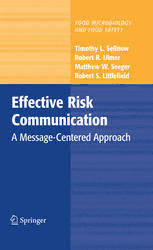
Effective Risk Communication: A Message-Centered Approach PDF
Preview Effective Risk Communication: A Message-Centered Approach
Effective Risk Communication FOODMICROBIOLOGYANDFOODSAFETYSERIES Food Microbiology and Food Safety publishes valuable, practical, and timely re- sourcesforprofessionalsandresearchersworkingonmicrobiologicaltopicsassoci- atedwithfoods,aswellasfoodsafetyissuesandproblems. SeriesEditor Michael P. Doyle, Regents Professor and Director of the Center for Food Safety, UniversityofGeorgia,Griffith,GA,USA EditorialBoard FrancisF.Busta,Director,NationalCenterforFoodProtectionandDefense,Uni- versityofMinnesota,Minneapolis,MN,USA BruceR.Cords,VicePresident,Environment,FoodSafety&PublicHealth,Ecolab Inc.,St.Paul,MN,USA CatherineW.Donnelly,ProfessorofNutritionandFoodScience,UniversityofVer- mont,Burlington,VT,USA Paul A. Hall, President, AIV Microbiology and Food Safety Consultants, LLC, HawthornWoods,IL,USA AilsaD.Hocking,ChiefResearchScientist,CSIRO—FoodScienceAustralia,North Ryde,Australia Thomas J. Montville, Professor of Food Microbiology, Rutgers University, New Brunswick,NJ,USA R.BruceTompkin,FormerlyVicePresident-ProductSafety,ConAgraRefrigerated PreparedFoods,DownersGrove,IL,USA Titles Effective Risk Communication: A Message-Centered Approach, Timothy L. Sellnow,RobertR.Ulmer,MatthewW.Seeger,RobertS.Littlefield(Eds.)(2009) FoodSafetyCulture,FrankYiannas(2009) MolecularTechniquesintheMicrobialEcologyofFermentedFoods,LucaCocolin andDaniloErcolini(Eds.)(2008) VirusesinFoods,SagarM.Goyal(Ed.)(2006) FoodborneParasites,YnesR.Ortega(Ed.)(2006) PCRMethodsinFoods,JohnMaurer(Ed.)(2006) Timothy L. Sellnow • Robert R. Ulmer • Matthew W. Seeger • Robert S. Littlefield Effective Risk Communication A Message-Centered Approach 123 TimothyL.Sellnow,Ph.D. RobertR.Ulmer,Ph.D. UniversityofKentucky UniversityofArkansas Dept.Communication LittleRock 249GrehanBuilding Dept.SpeechCommunication Lexington 2801SouthUniversity KY40506-0042 LittleRockAR72204–1099 USA USA MatthewW.Seeger,Ph.D. RobertS.Littlefield,Ph.D. WayneStateUniversity NorthDakotaStateUniversity 906WestWarren Dept.Communication DetroitMI48202 P.O.Box5075 USA FargoND58105 USA ISBN978-0-387-79726-7 e-ISBN978-0-387-79727-4 DOI:10.1007/978-0-387-79727-4 LibraryofCongressControlNumber:2008936988 (cid:1)c 2009SpringerScience+BusinessMedia,LLC Allrightsreserved.Thisworkmaynotbetranslatedorcopiedinwholeorinpartwithoutthewritten permission of the publisher (Springer Science+Business Media, LLC, 233 Spring Street, New York, NY10013,USA),exceptforbriefexcerptsinconnectionwithreviewsorscholarlyanalysis.Usein connectionwithanyformofinformationstorageandretrieval,electronicadaptation,computersoftware, orbysimilarordissimilarmethodologynowknownorhereafterdevelopedisforbidden. Theuseinthispublicationoftradenames,trademarks,servicemarks,andsimilarterms,eveniftheyare notidentifiedassuch,isnottobetakenasanexpressionofopinionastowhetherornottheyaresubject toproprietaryrights. Printedonacid-freepaper 9 8 7 6 5 4 3 2 1 springer.com Acknowledgments The foundation for this work coincides with the 2003 launching of the National Center for Food Protection and Defense (NCFPD), a Department of Homeland SecurityCenterofExcellence.Throughouttheplanning,implementation,andevo- lutionoftheNCFPD,riskcommunicationhasbeenacentralfeature.Wearegrateful toWillHueston,MikeOsterholm,FrankBusta,andShaunKennedyforrecognizing theimportanceofriskcommunicationandforguidingandsupportingourwork.The NCFPDhasconsistentlycreatedopportunitiesforleadingscholarsinriskcommu- nicationtogather,debatebestpractices,conductevaluations,andofferrecommen- dations.Assuch,weappreciatetheparticipationandinfluenceofNickAlexander, KrisBoone,LisaBrienzo,TonyFlood,BobGravani,MariaLapinski,JulieNovak, PeterSandman,ShariVeil,andStevenVenette.Wehavealsohadthegoodfortune to work with a number of promising graduate students on this project. In particu- larwethankDevonWood,WillWhiting,KathleenVidoloff,JenniferReierson,and Elizabeth Petrun for their work with NCFPD case studies, including those found in this book. We also extend our thanks to Kimberly Cowden, Kelly Wolf, Nicole Dobransky,ElizabethWebb,andAlyssaMillnerfortheircontributions.Asalways, we extend our thanks to Chandice Johnson whose skills as an editor are second tonone. This research was supported by the U.S. Department of Homeland Security (GrantnumberN-00014-04-1-0659),throughagrantawardedtotheNationalCen- terforFoodProtectionandDefenseattheUniversityofMinnesota.Anyopinions, findings, conclusions, or recommendations expressed in this publication are those of the author(s) and do not represent the policy or position of the Department of HomelandSecurity. v Contents Part I Conceptualizing a Message-Centered Approach to RiskCommunication 1 IntroducingaMessage-CenteredApproachtoRiskCommunication.. 3 DistinguishingBetweenRiskandCrisis............................. 4 AWorkingDefinitionofRiskCommunication ....................... 4 InteractiveProcess......................................... 5 MultipleMessages......................................... 7 ConstruingRiskMessages ........................................ 8 MeaningfulAccess .............................................. 9 AMessage-CenteredFocus ....................................... 10 RiskCommunicationasInteractingArguments....................... 11 ConvergenceVersusCongruence................................... 13 ConvergenceVersusMutualExclusivity............................. 14 ConvergenceVersusDominance ................................... 15 ConvergenceandMultipleSources ................................. 15 FocusoftheBook ............................................... 16 Summary ...................................................... 16 References ..................................................... 17 2 BestPracticesforRiskCommunication ........................... 19 ConceptofBestPractices ......................................... 19 BestPracticesforRiskCommunication ............................. 21 InfuseRiskCommunicationintoPolicyDecisions .............. 21 TreatRiskCommunicationasaProcess ....................... 22 AccountfortheUncertaintyInherentinRisk................... 23 DesignRiskMessagestobeCulturallySensitive................ 23 AcknowledgeDiverseLevelsofRiskTolerance ................ 24 InvolvethePublicinDialogueaboutRisk ..................... 25 PresentRiskMessageswithHonesty.......................... 26 vii viii Contents Meet Risk Perception Needs by Remaining Open andAccessibletothePublic................................. 27 Collaborate and Coordinate About Risk with Credible InformationSources........................................ 28 Summary ...................................................... 29 References ..................................................... 30 3 MultipleAudiencesforRiskMessages ............................ 33 SenderVersusAudience-CenteredCommunication.................... 34 IdentificationofMultipleAudiences................................ 34 TheUniversalandParticularAudiences ............................. 35 IdentificationofStakeholders................................ 35 MessageConstruction ...................................... 36 SpheresofEthnocentricity .................................. 38 DimensionsofCultureAffectingReceptivity......................... 39 TheImpactofCultureonCommunication ........................... 40 CodeSystems................................................... 41 PerceivedRelationshipandIntent .................................. 42 KnowingandAcceptingNormativeBeliefsandValues ................ 42 Worldview ..................................................... 43 ApplicationsofInteractingArguments .............................. 45 BenefitsofCulture-CenteredApproach ............................. 46 Summary ...................................................... 47 References ..................................................... 48 PartII CasesinRiskCommunication 4 TheCaseStudyApproach ....................................... 53 JustificationfortheCaseStudyApproach ........................... 54 LegitimacyasaMethodologicalApproach..................... 54 UtilityforInvestigationintoContemporaryEvents .............. 58 EnhancementofKnowledgeAboutComplexPhenomena ........ 58 EstablishingaFrameworkforCaseStudies .......................... 59 FiveCasesofRiskCommunication................................. 59 Summary ...................................................... 62 References ..................................................... 63 5 Cryptosporidium:UnanticipatedRiskFactors ...................... 65 Managing Risk Communication in Milwaukee’s Water TreatmentFacility ............................................... 65 ApplyingtheBestPracticesofRiskCommunicationtotheMilwaukee CryptosporidiumOutbreak........................................ 68 AccountfortheUncertaintyInherentinRisk................... 68 CollaborateandCoordinateaboutRiskwithCredible InformationSources........................................ 70 InfuseRiskCommunicationintoPolicyMaking ................ 72 ImplicationsforEffectiveRiskCommunication ...................... 73 Contents ix ListenforPotentialRisk .................................... 73 CommunicateEarlyandOftenaboutRisk ..................... 74 LearningisEssentialtoEffectiveRiskCommunication .......... 74 References ..................................................... 74 6 Hurricane Katrina: Risk Communication in Response to a NaturalDisaster................................................ 77 ManagingRiskCommunicationDuringHurricaneKatrina ............. 77 ApplyingtheBestPracticesinRiskCommunicationto HurricaneKatrina ............................................... 80 InfuseRiskCommunicationintoPolicyMaking ...................... 80 CollaborateandCoordinateAboutRiskwithCredible InformationSources........................................ 82 PresentRiskMessageswithHonesty.......................... 84 ImplicationsforEffectiveRiskCommunication ...................... 86 InfuseRiskCommunicationintoPolicyMaking ................ 86 MeetRiskPerceptionNeedsbyRemainingOpenand AccessibletothePublic .................................... 86 CollaborateandCoordinateAboutRiskwithCredible InformationSources........................................ 87 References ..................................................... 88 7 NewZealandBeefIndustry:RiskCommunicationinResponsetoa TerroristHoax ................................................. 91 ManagingRiskCommunicationDuringaTerroristHoax inNewZealand ................................................. 91 ApplyingtheBestPracticesinRiskCommunicationtotheTerrorist HoaxinNewZealand ............................................ 92 AccountfortheUncertaintyInherentinRiskCommunication..... 92 InfuseRiskCommunicationintoPolicyMaking ................ 93 CollaborateandCoordinateAboutRiskCommunicationwith CredibleInformationSources................................ 94 Involve the Public in the Dialogue About RiskCommunication....................................... 96 Meet the Risk Perception Needs by Remaining Open andAccessibletothePublic................................. 97 PresentRiskMessageswithHonesty.......................... 97 TreatRiskCommunicationasaProcess ....................... 98 AcknowledgeDiverseLevelsofRiskTolerance ................ 99 LearningthroughaHoax....................................100 References .....................................................102 8 Odwalla:TheLong-TermImplicationsofRiskCommunication......105 ManagingRiskCommunicationDuringanE.Coli OutbreakatOdwalla .............................................105 x Contents Applying the Best Practices in Risk Communication totheE.coliOutbreakatOdwalla..................................107 Meet Risk Perception Needs by Remaining Open andAccessibletothePublic.................................108 PresentRiskMessageswithHonesty..........................109 AcknowledgeDiverseLevelsofRiskTolerance ................109 CollaborateandCoordinateAboutRiskCommunicationwith CredibleInformationSources................................110 InfuseRiskCommunicationintoPolicyDecisions ..............111 ImplicationsforEffectiveRiskCommunication ......................113 TheImportanceofConsistentEthicalBehaviorsPre-Crisis .......113 TheImportanceofQuickActioninRiskCommunication ........113 TheImportanceofConcernandEmpathy......................114 TheImportanceofEthicalCommunicationandResources........114 The Importance of Organizational Learning and IndustryConsideration .....................................115 References .....................................................116 9 ConAgra:AudienceComplexityinRiskCommunication............119 ManagingRiskCommunicationDuringaSalmonellaOutbreak .........119 Applying the Best Practices of Risk Communication totheSalmonellaOutbreakatConAgra .............................121 DesignRiskMessagestobeCulture-Centered..................121 AcknowledgeDiverseLevelsofRiskTolerance ................124 AccountforUncertaintyInherentinRisk ......................124 PresentRiskMessageswithHonesty..........................125 Meet the Risk Perception Needs by Remaining Open andAccessibletothePublic.................................126 Collaborate and Coordinate About Risk with Credible InformationSources........................................126 ImplicationsforEffectiveRiskCommunication ......................127 AvoidUnethicallyShiftingtheBlameinRiskCommunication ....127 AvoidOver-reassuringinRiskCommunication.................127 RiskCommunicationshouldbeCulturallySensitive.............128 References .....................................................128 Part III Applications of a Message-Centered Approach to RiskCommunication 10 TowardaPracticeofMindfulness ................................133 MindfulnessasQuestioningtheRoutineResponse ....................134 HighReliabilityOrganizationsasModelsofMindfulness ..............136 Anticipation ..............................................136 Containment ..............................................137 MindfulnessandConvergence .....................................139
